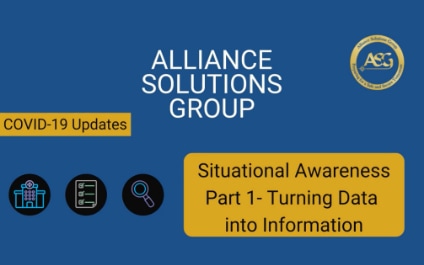Currently, news reporting is full of statistics regarding the COVID-19 pandemic, which can lead to mental exhaustion for citizens and those in positions of leadership. Translating data into useful information is important in avoiding overload and responding appropriately. Alliance Solutions Group (ASG) developed a course called Crisis Leadership and Decision Making for the Federal Emergency Management Agency (FEMA). This course has been delivered to over one thousand leaders across the United States over the past three years. An important concept from that course is enhancing situational awareness, which is the degree of sensing reality based on our perceptions. According to Endsley’s model of situational awareness, the first level is perception. Part 1 of this four-part series examines perception of data in the context the COVID-19 pandemic.
To make sense of data, you must first evaluate its context. When looking at a set of data, here are some things to be considered: What is the source? Is it reliable? Is it timely? Accurate? Valid?
Limitations of data using COVID-19 as an example:
- Limiting factor for COVID-19 data: Not everyone who should be tested can be tested, because there are not enough tests; therefore, statistics based on selective testing is not an accurate representation of the entire population.
- Clinical sampling error: Not everyone who is collecting clinical specimen will be as accurate as a fully-trained medical professional, causing a margin for error.
- Analytical error: Some tests have a true-positive rate of only ~70%, leading to underreporting.
- Mortality: the number of deaths divided by the number of cases. Underreporting of cases leads to an inflated mortality rate.
- Comparing US morbidity and mortality rates to other countries, which are also underreporting cases for the abovementioned reasons, can be flawed. Some cultural factors such as differences in personal space make comparisons between countries unreliable.
- Comorbidities are not often considered when determining cause of death.
- Location: Where are the majority of cases located? Rural and urban centers will have different mortality rates and rates of infection. Data should be viewed at the local level in order to make the best decisions, not at the national or state level.
ASG is committed to providing solutions to prepare communities for a safer, more secure tomorrow. To help leaders navigate the current crisis safely and effectively, ASG is leveraging its library of innovative products and services such as courses that have been used to train thousands of first responders, military, medical workers, and industrial workplaces on infectious disease control and prevention. To learn more about how ASG could support you during this time, visit www.asg-inc.org or call 757-223-7233.
Don't worry, no spam here!
Keep up to date with the latest trends, best practices and innovations in the Emergency Management and Environmental, Health and Safety sectors.

